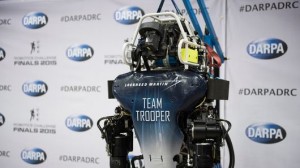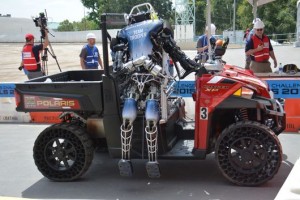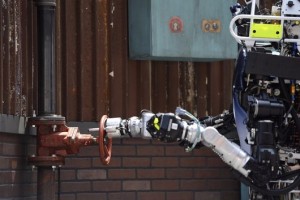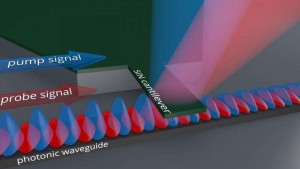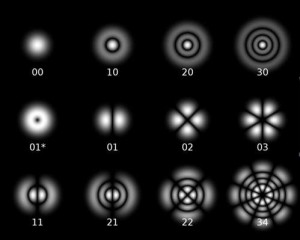Interview: Lockheed Martin’s Todd Danko on the DRC Finals and the future of robotics
Team Trooper’s robot named Leo competed in the recent DARPA Robotic Challenge
One of the 24 teams competing at the 2015 DARPA Robotics Challenge, and the only team fielded by a large private company, was Lockheed Martin’s Team Trooper and its robot Leo. To find out more about what goes into programming a humanoid robot and the future of robotics, we talked to the team leader, Todd Danko.
Danko: The whole point is to look for new opportunities. We think that investing in mobile manipulation, which is effectively what we’re doing, will be very useful in future applications like underwater or space robotics; places where it’s very difficult or impossible to get people to do those tasks. You can use our systems to tell robots what to do, and let the robots do those things.
Why did Lockheed opt for using Boston Dynamics’s humanoid Atlas robot?
We’re in a world that’s complementary to the humanoid form. If you have a very constrained task, like in a factory, a humanoid isn’t the right answer. You want to optimize your robot to solve those problems. If you don’t have a single problem to optimize, and you want a more general robot, then a humanoid robot makes more sense.
Does the humanoid robot produce any challenges in creating software?
It produces tremendous challenges. For a humanoid robot just to stay still and not fall over if you touch it. That’s a lot of software on its own. You have to have a good dynamic model of the robot and run it constantly at a thousand Hertz, so it’s harder for the robot to fall over. Meanwhile, a robot with wheels, if you turn everything off, it will be mechanically stable. It just sits there.
Were there any surprises working on this project?
Generally, one thing that surprised me is the state of the art of robotics and especially humanoid robotics. It’s one thing to see them in a movie or some real robots in specific demos, but with those demos you’re seeing the best of what could be, so the state of the art is actually a lot more primitive than many people think it is. It’s exciting to be able to help grow that
It’s a poor analogy, but what would you compare a humanoid robot of today to in terms of its development?
I could get into trouble because I don’t have much expertise in human development, but one of our goals was to work toward a robot with the capabilities of a two-year old. I can’t say that we exceeded that or didn’t, but like a two-year old, there’s definitely some misbehavior in these robots. They don’t always do what we tell them to.
We noticed in the competition that the robots moved very slowly with a lot of starting and stopping while they solved a problem or awaited an order. What hurdles have to be overcome before we see robots are that are fast and articulate enough to be practical?
There are two sides to this. On one side, robots are already practical in many ways. Probably the most successful robots are much more simple than those [at the competition]. On top of that, you have to consider what are the consequences of an error, so if you have a lot of runs or a lot of time, you may give your autonomous system a lot of latitude to make decisions rather than constantly approving it before it proceeds. In a competition like this, there are greater consequences and if a mistake happens that a human can stop, then we should prevent that from happening.
Secondly, there a lots of things that different groups are working on to improve the performance of robots as a whole. You notice that the robots are untethered. Powerwise, they were lasting an hour at least in most cases, but how useful is an hour of robot time? Maybe you want something that lasts a day or a couple of days even. We need better batteries, better power systems, and more efficient actuators, so there’s more power and less use of power down the line.
I’ve never met a perception algorithm that couldn’t use more processors to be better. Equally with planning and parallelizing, this provides more possibilities to come up with more solutions. Then there’s perception. There’s still a lot of room for improvement in the state of the art in perception. We’re very good at recognizing specific objects, but more needs to be done in recognizing categories of objects, or to recognize something never seen before and how that could be used.
On top of all this, I think there’s still a role for the human to help the robot know what it is that needs to be done. It may be best to have a human in a safe place who can communicate the “what” and allow the robot to do the dangerous things. That’s something I think we can see in the near future.
It’s the cliché question, but how long do you think it will be before we see robots like this as part of people’s lives?
It’s going to be a long time before we see a robot like this. Look at what [happened in the competition] and how many people it took to keep that robot from destroying itself. There’s a lot of work that needs to be done before we’re contributing in a way that’s not a burden to the operators. That goes back to all those things we talked about that need to be improved, so it’s going to be quite some time. On the other hand, simple robots are already being used in applications today. We’re just using more complicated robots in more complicated situations as we go in that direction of complexity.
References:http://www.gizmag.com/

